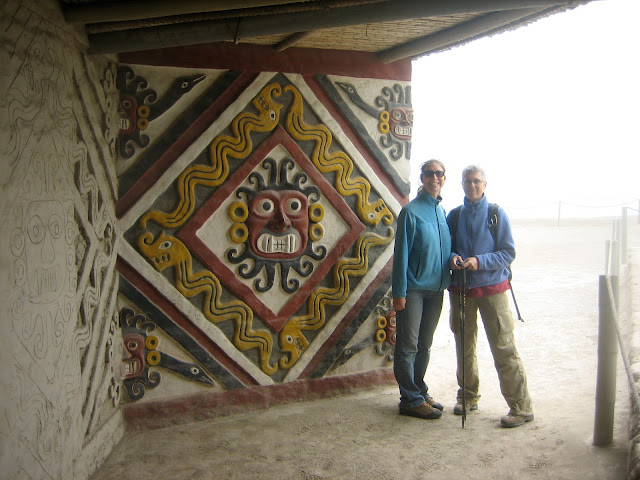We based ourselves in Trujillo for Chan Chan, Huaca de la Luna, and el Brujo; the first two sites are a short collectivo ride (i.e., local minibus service) outside the city, and el Brujo is about an hour distant. There isn't a heck of a lot going on in Trujillo itself, although there was quite a bit of interesting colonial architecture.
 One of many ornate screened balconies where a lady might look out on the street without being seen from below.
One of many ornate screened balconies where a lady might look out on the street without being seen from below.Most memorable, however, is the sketchy guesthouse in which we caught one of the desk clerks in our bathroom, claiming to be cleaning it at six o'clock in the evening (naturally, with no cleaning products to hand). Nothing was missing from the room, but I was still suspicious. 'He was sticking his nose in our underwear,' I said. 'It's the only logical explanation.'
 Chan Chan, built by the Chimú in the ninth century, was a vast city constructed entirely of adobe. Plentiful pelican, fish, and otter motifs, and the diamond-shaped walls (fishing nets!), show how the Chimú appreciated what the sea provided.
Chan Chan, built by the Chimú in the ninth century, was a vast city constructed entirely of adobe. Plentiful pelican, fish, and otter motifs, and the diamond-shaped walls (fishing nets!), show how the Chimú appreciated what the sea provided. (See the otters on the walls?)
(See the otters on the walls?)The next day we did Huaca de la Luna (Moon Handbooks link here), the 'Temple of the Moon.' I think this was our favorite archaeological site (it was definitely mine)—fascinating polychrome wall reliefs (giant spiders, vanquished warriors in neck chains being led to sacrifice), excellent guide, totally adorable Peruvian schoolgirls. There are two huge adobe structures here, both constructed by the Moche people layer upon layer over successive generations during the first millennium A.D.—the Temple of the Moon was used for religious and ceremonial purposes, the nearby Temple of the Sun for the military and administrative stuff. The Temple of the Sun, looted by the conquistadores, is still undergoing excavation work and isn't yet open to the public. Children used to play soccer on the sand before these ruins were discovered underneath.
 I know this shot must look kind of posed and phony, but honestly it isn't—our guide was about to snap a photo of the three of us, and these adorable little girls were shyly watching on, and we invited them to come over.
I know this shot must look kind of posed and phony, but honestly it isn't—our guide was about to snap a photo of the three of us, and these adorable little girls were shyly watching on, and we invited them to come over.I also took a panorama at Huaca de la Luna—I don't know why it's playing so jerkily, but you get the idea:
By our last day in Trujillo we were a little bit ruined out, but el Brujo (another city constructed by the Moche between 1400 and 2000 years ago) was still very much worth the visit, particularly for the Señora de Cao, a young woman who was evidently a very powerful political leader. Her mummy was discovered in 2006 along with a fifteen-year-old handmaiden sacrificed presumably to tend to her needs in the afterlife; experts concluded the Señora had died in childbirth around the age of twenty.
 What the walls probably would have looked like a millennium and a half ago. If I remember correctly, this is Ayapec, 'the great decapitator.' Eep!
What the walls probably would have looked like a millennium and a half ago. If I remember correctly, this is Ayapec, 'the great decapitator.' Eep!The brand-new museum at el Brujo houses the mummy of the Señora de Cao, and you can still see the undulating tattoos on her arms. I was really fascinated to discover that when you look into the glass case you aren't actually looking at the Señora, but at a mirror image; the mummy is lying safely out of sight. I was trying to figure out why the sight of the mummy at Sechin bothered me so much when I was only in awe of the Señora—it must be because of who they were in life. The Señora was entombed in layers of precious cloth and gold baubles, while it seems cruel to display the body of the sacrificed girl when she'd already had to suffer that supreme indignity. Anywho.
Next post: THE JUNGLE!


1 comment:
I still think that if he was sniffing my underwear, he was hurt more than I was.
Post a Comment